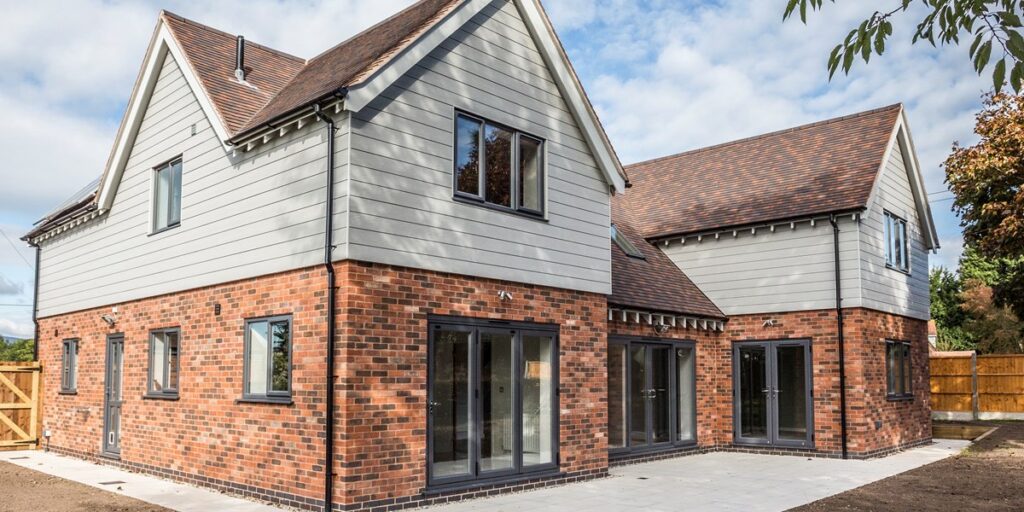Cladding is a common choice for homeowners looking to enhance the appearance and durability of their houses without a lot of upkeep. It adds a stylish touch to your home while also offering extra insulation and protection from the weather.
Some people might think cladding is an unnecessary expense, but it can be a smart investment in your home’s upkeep and resale value. Understanding the different materials used for cladding can help you pick the right one for your house.
Here are four very easy types of cladding that can make your house look better without needing a lot of work:
Table of Contents
- Fibre-Cement Cladding
- Metal Cladding
- Natural Timber Cladding
- Modified Timber Cladding
- Final Thoughts
- FAQs
- What are the main benefits of using cladding for homeowners?
- What are the key differences between fibre-cement cladding and metal cladding?
- How long can homeowners expect different types of cladding materials to last?
- What are the main considerations when choosing between natural timber cladding and modified timber cladding?
Fibre-Cement Cladding
Fibre-cement cladding is a type of covering for buildings that don’t cost a lot and doesn’t need much upkeep. It’s made by mixing cement, cellulose, fillers, fibers, and water to form panels. These panels are made by people and can be found in many different colors and finishes.
Fibre-cement cladding panels are a good choice because they’re affordable and last for over 40 years with very little maintenance needed. You just have to clean them once a year. There are also versions of these panels that are painted. These have a special layer on top that makes them resistant to water, so they won’t rust or rot. This means you don’t have to spend a lot of time taking care of them.

Metal Cladding
Metal cladding costs more than fibre-cement cladding, but it’s strong and flexible for protecting homes. You can choose from steel, aluminum, copper, or zinc for metal cladding.
Metal cladding typically lasts about 35 to 40 years, depending on the type of metal and how well it’s looked after. Even though the materials are treated to keep them shiny, they still need yearly cleaning, similar to fibre-cement cladding.
Natural Timber Cladding
Many people like using natural wood for cladding because it gives their homes a nice, cozy look. Different types of trees have different colors and patterns, so each home can have a special appearance.
But there’s a problem with using wood: it doesn’t last as long as other materials. Some kinds of wood soak up water easily, and others shrink as they get older. That’s why it’s important to treat the wood with special chemicals to help it last longer.
Modified Timber Cladding
If you want your house to look like it’s made of real wood but want it to stay strong and last longer with less work, then modified timber cladding might be just what you need. This kind of cladding uses wood that’s been changed with chemicals or heat to make it tougher, more durable, and better at resisting rot compared to regular wood.
Popular brands like Accoya and Kebony can keep your house looking great for about 35 years without needing a lot of maintenance. Unlike regular wood, the top layer of modified timber cladding lasts longer and helps the color of the wood stay nice even as it weathers over time.
Final Thoughts
Cladding is a great way to make your home more resistant to weather and make it look nicer. Different types of cladding make your home look different and last longer. That’s why it’s important to choose the right materials to get the best result.
If you’re in the UK and need good quality wood cladding that’s cut to the size you need, we have what you’re looking for. Contact us now to find all the wood you need in one place.
FAQs
What are the main benefits of using cladding for homeowners?
The main benefits of using cladding for homeowners include enhancing the appearance and durability of their houses with minimal upkeep. Cladding adds style, extra insulation, and protection from weather conditions.
What are the key differences between fibre-cement cladding and metal cladding?
Fibre-cement cladding is affordable and requires minimal maintenance, lasting over 40 years. On the other hand, metal cladding is strong and flexible, with options like steel, aluminum, copper, or zinc. Metal cladding typically lasts about 35 to 40 years, depending on the type of metal and maintenance.
How long can homeowners expect different types of cladding materials to last?
Homeowners can expect fibre-cement cladding to last over 40 years with minimal maintenance, while metal cladding typically lasts about 35 to 40 years. Natural timber cladding may not last as long due to water absorption and shrinking, while modified timber cladding can last around 35 years with less maintenance.
What are the main considerations when choosing between natural timber cladding and modified timber cladding?
When choosing between natural timber cladding and modified timber cladding, homeowners should consider durability and maintenance. Natural wood offers a cozy look but requires treatment to withstand water absorption and shrinking. Modified timber cladding, treated with chemicals or heat, is tougher, more durable, and better at resisting rot compared to regular wood.

